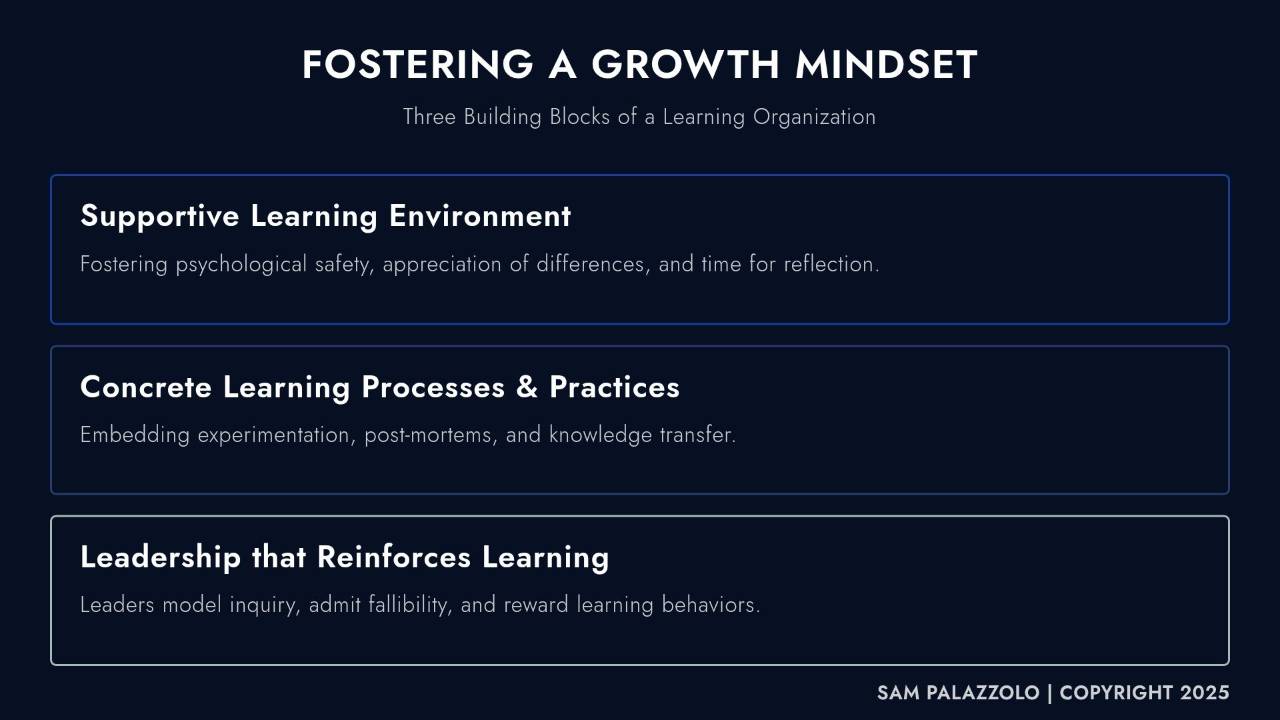Fostering a Growth Mindset: The Operating System Behind Sustainable Scale
Aug 18, 2025
Leaders often say they want innovation while running cultures where mistakes are punished and learning is optional. That gap—not market conditions—quietly caps growth. The evidence is compelling: in organizations that deliberately cultivate a growth mindset, employees are 65% more likely to say their company supports risk-taking and 49% more likely to say it fosters innovation (Harvard Business Review). Yet overall employee engagement in the U.S. fell to 31% in 2024, a ten-year low (Gallup). Conversely, when companies invest in learning, 7 in 10 people report stronger connection to the organization and 8 in 10 say learning adds purpose to their work (LinkedIn Workplace Learning Report 2024).
The takeaway is clear: mindset becomes material when it is operationalized. The most practical blueprint comes from Harvard Business Review’s “Three Building Blocks of a Learning Organization”—a framework that converts growth-mindset aspirations into weekly habits and measurable outcomes (Garvin, Edmondson, & Gino).
From Slogan to System: The Learning Organization Blueprint
The model comprises three mutually reinforcing components that are simple to deploy at pace.
1) Supportive Learning Environment
A supportive environment features psychological safety, appreciation of diverse viewpoints, and time for reflection. Tactically, this can start with short “what I learned last week” openers in team meetings and leaders sharing recent mistakes and what changed as a result. These signals normalize discussing uncertainty and accelerate the flow of tacit knowledge.
2) Concrete Learning Processes & Practices
Learning needs structure. Embed micro-retrospectives (30 minutes, blameless) after projects or sprints; run small, reversible experiments with explicit success criteria; and document changes in a shared Learning Changelog so improvements compound. Practices like after-action reviews, light-weight data collection, and knowledge transfer sessions provide the plumbing that keeps insights moving across teams.
3) Leadership that Reinforces Learning
Leaders make learning visible. Ask more questions than you answer, model inquiry, and reward the behaviors that create better future outcomes (experimentation, knowledge sharing, post-mortems)—not just the short-term wins. Two questions work especially well in 1:1s: “What did you try?” and “What did you learn?” When these questions become routine, experimentation ceases to be exceptional—it becomes expected.
Real-World Examples: Where the Flywheel Catches
Product Organization. Facing missed release targets and risk aversion, a general manager publicly shared two mistakes and the resulting process changes. Teams ran bi-weekly micro-retros and launched one “1% experiment” per sprint with pre-defined metrics. In the following quarter, the group documented 18 experiments, shipped six improvements, reduced cycle time on a core workflow by 14%, and saw a double-digit rise in “safe to speak up” scores on the pulse survey.
Customer Operations. A service team replaced ad-hoc problem solving with structured after-action reviews and a searchable repository of fixes. Team leads recognized contributions to the repository in monthly forums. Within two months, first-contact resolution increased and onboarding time for new hires fell due to faster knowledge transfer.
These examples share the same pattern: small, durable changes in rituals and recognition yielded measurable gains in speed, quality, and engagement.
Making It Operational in Seven Days
The most common objection is time. The truth: installing a learning operating system can start this week without disrupting the plan of record.
Week-One Rollout
- Day 1 (Leadership Signal). Publish a brief note on a recent mistake and what changed. Set the tone for psychological safety.
- Day 2 (Process). Run one 30-minute micro-retro on a live workflow; capture three improvements and owners in a shared document.
- Day 3 (Experimentation). Launch a “1% experiment” per team—tiny, reversible, with one success metric and a due date.
- Day 4 (Manager Cadence). In 1:1s, ask only the two learning questions and record answers in a shared log.
- Day 5 (Knowledge Transfer). Publish a one-page Learning Changelog summarizing experiments, retro outcomes, and next steps.
- Day 6–7 (Capacity). Block 60 minutes for skill practice or a course and schedule the next week’s experiment.
This cadence creates momentum with minimal overhead, while making learning a visible, scored activity rather than an aspiration.
Addressing the Skeptics
Meta-analyses of growth-mindset interventions show small average effects on achievement, with stronger results for specific at-risk groups and when implementation quality is high (Psychological Science). That nuance matters. The implication for leaders is not to abandon mindset but to anchor it in operating mechanisms—safety, systems, and leadership behaviors—so the benefits show up in throughput, quality, and talent development.
Closing Thoughts: Action Today, Compounding Tomorrow
Scaling amplifies everything—good systems and bad habits alike. Installing a growth-mindset operating system ensures that mistakes become institutional knowledge, experiments become routine, and leaders become teachers. Start with visible leadership signals, codify learning processes, and reward the behaviors that create better outcomes next quarter. The compounding effect will show up in speed, engagement, and innovation capacity.
Sam Palazzolo, Principal Officer @ The Javelin Institute
For more practical playbooks like this, sign up for the Business Scaling newsletter: https://sampalazzolo.com/
SUBSCRIBE FOR WEEKLY BUSINESS SCALING STRATEGIES
REAL STRATEGIES. REAL SOLUTIONS.
We respect your privacy. Unsubscribe at any time.
